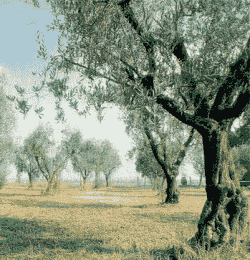
We're an all volunteer website and need your help to keep going. Here are five ways you can contribute: 1 Donate 2 Buy something 3 Submit a story 4 Volunteer 5 Advertise

New in the gift shop, virtualitalia.com logo wear and use items! 
|
PLEASE NOTE: We are experiencing unexpected
technical difficulties caused by our web host. We apologize for
the inconvenience. During your visit you may experience service
and page interruptions - we are in the process of fixing everything and hope to be
fully back on our feet soon.
the early beginnings of olive oil
The importance of Olive oil continued to increase during the Roman Empire to the point where the Empire's Southern regions were organized around oil provinces. However, the collapse of the Roman Empire signaled the end of the cultivation of the olive tree, The ancient plant survived only around convents and in the fortified regions high in the hills of Tuscany. In 1100 AD, olive groves again begin to propagate in Italy with Tuscany becoming the primary center for the cultivation of the olive tree. Strict laws were issued during that time, regulating the cultivation of the olives and the commerce of oil and, in fact, many of those same laws are still followed today. Venice and Genoa also began to trade oil and each year more and more oil was produced from the countries of the Mediterranean river basin. At the beginning of 1300 AD, Apuglia became an enormous olive grove and olive trees were planted in other regions of Italy, making it the center of olive oil production throughout the world. The wars of 1400 AD marked a critical time for oil production but it was only a short time before olive oil, especially Italian olive oil, rebounded and again became the lead player on the sumptuous renaissance tables of Europe. Olive Oil production leveled-off during the 1600's due to high taxes and did not begin to grow up until the early 1700's with the development of the free market and the exemption of taxes on olive groves. In the 1800's olive groves continued to flourish thanks to the monetary incentives guaranteed by the Papal State. Now, at the end of the 20th century olive oil continues to grow in popularity. One of the main reasons for the increased consumption of olive oil is the growing awareness of the Mediterranean diet and its positive effects on health. In the 1970's American scientists published several nutritional diets citing the correlation between the Mediterranean diet and lower incidences of health problems. Based on fresh vegetables, seasonal fruits, grains, fish, meats and olive oil, the studies confirmed that foods of the Mediterranean region are not only delicious but can be good for people as well.
from olive to oil In many regions of the Mediterranean, olives are still picked by hand, using wooden tools, or beaten from the trees with poles and caught in large nets. Other olive farmers now use machine harvesting, including trunk and branch shakers. Still others collect olives that fall naturally to the ground, or are nudged by wind and rain. To obtain the best oil, some growers harvest olives just as they change color, indicating that almost all the oil has formed and that they are at peak flavor. Once collected, olives are rushed to mills for same day or, at most, next day pressing -olives not pressed immediately begin to oxidize and ferment. The entire olive is used to make the oil; pulp, skin and even husk. Thousands of years ago, crushing was done by hand in spherical stone basins. Today, in a similar method, olives are crushed by mechanical stainless steel grindstones, and result in an olive paste. The paste is mixed with water, placed on circular hemp mats, stacked, and pressed. This "cold pressing" yields an olive liquid of oil and water which is later separated. It is the cold press method that enables olive oil to maintain its flavor, color and nutritional value. In fact, olive is the only oil which can be consumed as it is removed from the fruit. A gentle filtration process is used to remove sediment and produce extra virgin olive oil with an acidity level of less than 1%. Any oil with acidity above this level receives an additional refining step to remove almost all traces of color, aroma, taste and acidity, resulting in extra light tasting olive oil. In order to produce the grade of oil simply known as pure olive oil, extra virgin is added back to extra light to achieve the desired level of flavor and aroma. Like a fine wine, each variety of olive oil is evaluated by tasting and measuring acidity before bottling. Also like wine, no two olive oils are alike. Each is a unique product of soil, climate, olive variety and age, and processing method. Oils can be fruity or flowery, nutty or spicy, delicate or mild, and can range from clear, to pale green, to golden, to deep olive green in color. When properly processed, olive oil can fully maintain the flavor, aroma and vitamins of the eloquent olive from which it came.
olive oil classes Four basic types of olive oil are available and categorized by their quality characteristics which are:
The senses used in the evaluation of olive oil are: smell, sight and taste. The 'smell test' evaluates the intensity of the oils' scent, whilst the visual analysis looks at the oils' clarity, density and color. The final, and most important test determines the oils taste, it makes sure that the oil has a good, balanced flavor, and will establish whether or not the oil will have an unpleasant after taste.
slippery facts
olive oil tasting
|
© 1998-2005 by virtualitalia.com unless otherwise noted
 The olive tree has played a prominent role in the history of man; from the Pharaohs of
Egypt to present day, where the olive tree branch is a universal symbol for peace. At the
beginning of civilization, 4000 years before Christ, olive trees where brought to
Palestine from Armenia and were planted throughout the land. Thanks to the Phoenicians,
the great oil traders of ancient times, the precious liquid was then brought to Greece,
where it was revered for all its splendor. In addition to being a food, the Greeks used
olive oil as fuel for lamps, in sacred initiations and as a massage oil to prepare the skin
before fighting in the arena.
The olive tree has played a prominent role in the history of man; from the Pharaohs of
Egypt to present day, where the olive tree branch is a universal symbol for peace. At the
beginning of civilization, 4000 years before Christ, olive trees where brought to
Palestine from Armenia and were planted throughout the land. Thanks to the Phoenicians,
the great oil traders of ancient times, the precious liquid was then brought to Greece,
where it was revered for all its splendor. In addition to being a food, the Greeks used
olive oil as fuel for lamps, in sacred initiations and as a massage oil to prepare the skin
before fighting in the arena.
 Olives are harvested from November until March, six to eight months after their spring
blossoms appear. They require very warm average temperatures, and cannot tolerate cold
below 10� F (-12� C). They do well in very dry climates, and can tolerate droughts and
high winds. Not surprisingly, they grow beautifully in the Mediterranean, with its mild
winters and long, hot summers, where 98% of world's olive oil is harvested. Spain is the
largest producer of olive oil, followed by Italy and then Greece. Other major producers
include France, Turkey, Tunisia and Morocco.
Olives are harvested from November until March, six to eight months after their spring
blossoms appear. They require very warm average temperatures, and cannot tolerate cold
below 10� F (-12� C). They do well in very dry climates, and can tolerate droughts and
high winds. Not surprisingly, they grow beautifully in the Mediterranean, with its mild
winters and long, hot summers, where 98% of world's olive oil is harvested. Spain is the
largest producer of olive oil, followed by Italy and then Greece. Other major producers
include France, Turkey, Tunisia and Morocco.
